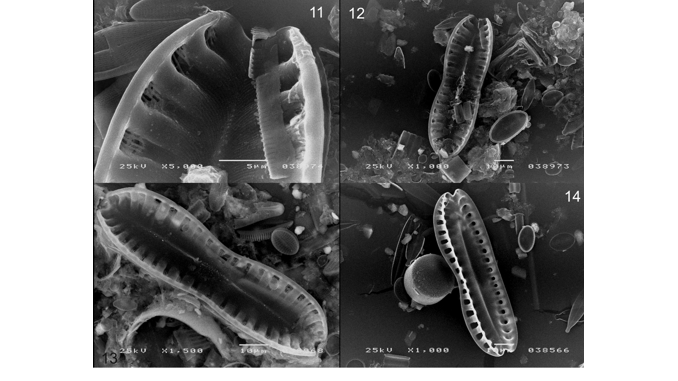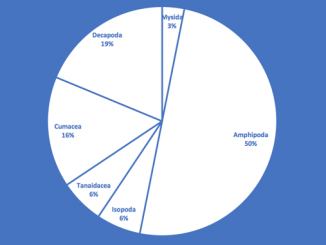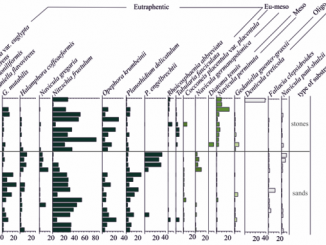
Paper category: Short communication
Corresponding author: Bogusław Szulc (b.szulc@algin.pl)
DOI: 10.1515/ohs-2017-0045
Received: March 20, 2017
Accepted: June 14, 2017
Full text: here
Citation (APA style):
Abstract
Diatoms of the genus Surirella are considered to be a very diverse group, many of them are endemic species found in old lakes as well as in tropical regions worldwide. This study describes a new location of Surirella barrowcliffia. In 2005-2007, algological research on the taxonomic composition of benthic diatoms was conducted in the middle section of the Pilica River (Central Poland). A total of 23 benthic samples were collected from a single sampling site located in the town of Sulejów (159.8 km upriver). Altogether 242 diatom species were identified in the collected material. One of the most interesting taxa in this community was S. barrowcliffia. According to the information available in the world’s algological databases, such as Algaterra and AlgaeBase, S. barrowcliffia has so far been found only in England, France, Finland, northern Germany – in the Weser and the Kleine Wumme rivers, near Bremen, and in Romania in the Crapina-Jijila lake complex. S. barrowcliffia has not been recorded in the previous research conducted not only in the middle section of the Pilica River, but also in other Polish aquatic ecosystems.
References
Amosse, A. (1932). Diatomées de la Loire-Inférieure. Bulletin de la Société des Sciences Naturelles de l’Ouest de la France, (Nantes) 5eme Sér. 2(1-3): 1-57.
Bramburger, A.J., Hamilton, P.B., Hehanussa, P.E. & Haffner, D.G. (2008). Processes regulating the community composition and relative abundance of taxa in the diatom communities of the Malili Lakes, Sulawesi Island, Indonesia. Hydrobiologia 615: 215-224.
Caraus, I. (2012). Algae of Romania. A distributional checklist of actual algae. Version 2.3 third revision. Bacau, Univ. Bacau.
Cleve-Euler, A. (1952). Die Diatomeen von Schweden und Finnland. Part V. (Schluss.) Kongliga Svenska Vetenskaps-Akademiens Handligar, 4, 3, 3, pp. 153.
Cocquyt, C. & Jahn, R. (2005). Rare Surirella taxa (Bacillariophyta) from East Africa described by Otto Müller: typifications, recombinations, new names, annotations and distributions. Willdenowia 35: 359-371.
Cocquyt, C. & Jahn, R. (2007a). Surirella nyassae O. Müller, S. malombae O. Müller and S. chepurnovii Cocquyt and R. Jahn sp. nov. (Bacillariophyta) – typification and variability of three closely related East African diatoms. Nova Hedwigia 84: 529-548.
Cocquyt, C. & Jahn, R. (2007b). Surirella engleri O. Müller – a study of its types, infraspecific variability and distribution. Diatom Research 22: 1-16.
Dembowska, E. (2014). Diatoms of the lower Vistula River phytoseston. Archives of Polish Fishery 22: 53-67.
Donkin, A.S. (1869). On several new and rare species of freshwater Diatomacae discovered in Northumberland. In E. Lankester & E.R. Lankester (Eds.), Quarterly Journal of Microscopical Science. John Churchill and Sons, New Burlington Street, London 9: 291-292.
Fourtanier, E. & Kociolek, J. P (2010). Catalogue of Diatom Names, version 2010. California Academy of Sciences USA. Available from: http://research.calacademy.org/research/diatoms/names/index.asp (accessed: 12 August 2015).
Guiry, M.D. & Guiry, G.M. (2017, March 18). AlgaeBase. World-wide electronic publication, National University of Ireland, Galway, http://www.algaebase.org.
Hartley, B., Barber, H.G., Carter, J.R. & Sims, P.A. (1996). An Atlas of British Diatoms. Biopress Limited, Bristol, pp. 601.
Hohn, M.H. & Hellerman, J. (1963). The taxonomy and structure of diatom populations from three eastern North American rivers using three sampling methods. Transactions of the American Microscopical Society 82: 250-329.
Hohn, M.H. & Hellerman, J. (1966). New diatoms from the Lewes-Rehoboth Canal, Delaware and Chesapeake Bay area of Baltimore, Maryland. Transactions of the American Microscopical Society 85: 115-130.
Hustedt, F. (1957). Die Diatomeenflora des Fluss-Systems der Weser im Gebiet der Hansestadt Bremen. Abhandlungen Herausgegeben vom Naturwissenschaftlicher Verein zu Bremen 34: 181-440.
Hustedt, F. (1959). Die Diatomeenflora des Salzlackengebietes im österreichischen Burgenland Österreichischen Akademie der Wissenschaften, Mathematische und Naturwissenschaftliche, Kl. Abt. 1,168(4/5): 387-452.
Kadłubowska, J.Z. (1964a). Okrzemki rzeki Pilicy i ich znaczenie w ocenie czystości wody. [Diatoms of the River Pilica and their role in the assessment of water quality]. ŁTN Łódź 97, pp. 61. (In Polish).
Kadłubowska, J.Z. (1964b). Okrzemki rzeki Pilicy i ich znaczenie w ocenie czystości wody. [Diatoms of the River Pilica and their role in the assessment of water quality]. II, Zeszyty Naukowe Uniwersytetu Łódzkiego 2(16): 93-150. (In Polish).
Kadłubowska, J.Z. (1964c). Okrzemki rzeki Pilicy i ich znaczenie w ocenie czystości wody. [Diatoms of the River Pilica and their role in the assessment of water quality]. Wydawnictwo Uniwersytetu Łódzkiego: 1-32. (In Polish).
Kadłubowska, J.Z., Ligowski, R., Rakowska, B. & Maksimiuk, Z. (1981). Flora glonów Bełchatowskiego Okręgu Przemysłowego. [Flora of algae of the Bełchatów Industrial District]. Acta Univ. Lodz., Folia bot. 1: 257-291. (In Polish).
Kalinowska-Kucharska, E. & Ligowski, R. (1976). Glony dorzecza Pilicy na odcinku Koniecpol-Tomaszów Mazowiecki. [Algae on a stretch of the River Pilica basin from Koniecpol to Tomaszów Mazowiecki]. Zeszyty Naukowe Uniwersytetu Łódzkiego 2(2): 207-240. (In Polish).
Krammer, K. & Lange-Bertalot, H. (1988). Bacillariophyceae. 2. Teil: Bacillariaceae, Epithemiaceae, Surirellaceae. In H. Ettl, J. Gerloff, H. Heynig & D. Mollenhauer (Eds.), Süsswasserflora von Mitteleuropa (pp. 596).
Lowe, R.L. (1973). Notes on Iowa diatoms X: New and rare diatoms from Iowa. Proceedings of the Iowa Academy of Science 79: 66-69.
Ludwig, G. & Schnittler, M. (1996). Rote Liste gefährdeter Pflanzen Deutschlands. Schriftenreihe für Vegetationskunde, pp. 744.
Maciejczak, B. & Czerwik-Marcinkowska, J. (2010). Macrophytes, cyanobacteria and algae of the “Brodzkie Lake” in the Małopolska Upland in southern Poland – preliminary study. Roczniki Akademii Rolniczej w Poznaniu 14: 67-76.
Medlin, L.K. & Kaczmarska, I. (2004). Evolution of the diatoms: V. Morphological and cytological support for the major clades and a taxonomic revision. Phycologia 43(3): 245-270.
Metzeltin, D. & Lange-Bertalot, H. (2002). Diatoms from the Island Continent Madagascar. Iconographica Diatomologica 11, pp. 286.
Noga, T., Stanek-Tarkowska, J., Pajączek, A., Peszek, Ł., Kochman, N. et al. (2013). Wstępne rozpoznanie okrzemek Bacillariophyceae Jeziorek Duszatyńskich (Bieszczady Zachodnie). [Preliminary recognition of diatoms Bacillariophyceae of the Duszatyńskie Lakes (Western Bieszczady Mts.)]. Roczniki Bieszczadzkie 21: 127-146. (In Polish).
Picińska-Fałtynowicz, J. (2007). Ecological status of the River Nysa Łużycka (Lausitzer Neisse) assessed by epilithic diatoms. Proceedings of the 1st Central European Diatom Meeting 2007. W.-H. Kusber & R. Jahn (Eds.) Botanic Garden and Botanical Museum Berlin-Dahlem, Freie Universität Berlin.
Regulation of the Council of Ministers, Poland (OJ No 70, pos. 821 from 2000).
Regulation of the Minister of the Environment, Poland (OJ No 258, pos. 1549 from 2011).
Round, F.E., Crawford, R.M. & Mann, D.G. (1990). The Diatoms: Biology and Morphology of the Genera. Cambridge University Press, Cambridge, pp. 747.
Schmidt, A., Schmidt, M., Fricke, F., Heiden, H., Müller, O. et al. (1874-1959). Atlas der Diatomaceen-Kunde. Reprint 1984, Koeltz Scientific Books, Königstein, pp. 480.
Szczepocka, E. & Rakowska, B. (2015). Diatoms in the biological assessment of the ecological state of waters using the Czarna Staszowska River as an example. Oceanol. Hydrobiol. St. 44 (2): 254-266.
Terry, W.A. (1907). A partial list of Connecticut diatoms with some account of their distribution in certain parts of the state. Rhodora 9: 125-140.
Turpin, P.J.F. (1828). Observations sur le nouveau genre Surirella. Mémoires du Museum d’Histoire Naturelle 16: 361-368.
Tynni, R. (1980). Über Finnlands rezente und subfossile Diatomeen, XI. – Geol. Surv. Finland Bull. 312: 1-93.
Van Heurck, H. (1880). Synopsis des Diatomées de Belgique. Atlas. Ducaju and Cie., Anvers., 30 pp.
Vesela, J. & Potapova, M. (2014). Surirella arctica comb. et stat. nov. (Bacillariophyta) – a rare arctic diatom. Phytotaxa 166(3): 222-234.
Whitton, B.A., John, D.M., Kelly, M.G. & Haworth, E.Y. (2003). A coded list of freshwater algae of the British Isles. Second Edition. World-wide Web electronic publication.
Wojtal, A., Wilk-Woźniak, E. & Bucka, H. (2005). Diatoms (Bacillariophyceae) of the transitory zone of Wolnica Bay (Dobczyce dam reservoir) and Zakliczanka stream (Southern Poland). Algological Studies 115(1): 1-35.
Zelazna-Wieczorek, J. (2011). Diatom flora in springs of Lódz Hills (Central Poland). Biodiversity, taxonomy and temporal changes of epipsammic diatom assemblages in springs affected by human impact. A.R.G. Gantner Verlag K.G., pp. 419.



Bądź pierwszy, który skomentuje ten wpis